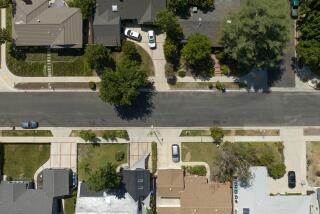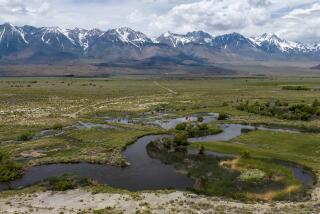A view of the drought from Down Under
That rain you’ve been having? It doesn’t really help much. California is still in the midst of a serious drought.
We Australians can empathize -- and we can also offer some advice.
Last year, the southeast corner of the northern Australian state of Queensland, where I live, entered its 10th year of drought -- officially the worst period on record. Australia is the driest inhabited continent on Earth, but until recently that was never a huge problem for the 90% of us who live in coastal cities and towns. We’d always thought of dry spells as the farmers’ problem.
But as the recent drought dragged on, fruit and vegetable prices began to rise. Then public parks went from green to brown. Finally, even city folk began to talk about drought.
In May 2005, restrictions were imposed on things like watering gardens, washing cars and filling pools. After that, I could only water the vegetable patch in my backyard with a bucket, and then only three times a week after 7 p.m. on my allotted days.
Despite the regulations, by mid-2007 our drought had become deeply alarming. The reservoirs that supply the state’s three most populous areas -- Brisbane, the Gold Coast and the Sunshine Coast -- were at 16% of normal.
The water authority, having instituted all possible outdoor restrictions, had no choice but to take water saving into people’s homes -- where the majority of water is used. It became personal.
The authority set a target of reducing average daily water use from 80 gallons a person to 37 gallons (or 140 liters) a person. The plan was to keep the 37-gallon target in place until the combined level of the reservoirs serving the region went back up to 40% of normal.
Officials developed a relatively cheap social marketing campaign, with the aim of getting people to think about individual water use. Ads promoted simple things, such as taking four-minute showers and turning off the tap while brushing your teeth.
Crucially, the program set targets, and for the first time put gallon figures on the amount of water used in car washing, toilet flushing and other activities.
Before the drought and Target 140, as the program was called, my wife, two sons (ages 8 and 11) and I routinely wasted water. Our faucets dripped, our sprinklers ran, we washed our cars and hosed our driveway without a second thought.
Now the radio was awash with talk of water and how to conserve it. Reservoir levels became the subject of everyday conversation.
Just two weeks into Target 140, average daily per-person use dropped from 80 to 32 gallons. The water saved was equivalent to bringing a desalination plant online -- overnight.
In the United States, people use an average of between 100 to 150 gallons a day, depending on whose statistics you use, so you’d have a little more cutting to do. But it was surprisingly easy. At my house, water-saving fever caught on quickly. We made sure to only do full loads of dish and clothes washing, we bought a four-minute shower timer, and we used a $15 government-funded, one-off plumbing service to fix leaking faucets and install water-saving shower heads. We took advantage of generous government rebates to install rainwater tanks and gray-water systems.
It was discouraging to watch the garden die and our green lawn turn to dust. But then so did everybody else’s. In fact, healthy gardens raised eyebrows and suspicions.
We tracked our progress in our water bill, which displayed household usage on a bar graph, along with our suburb’s average and the overall city average.
There were some isolated neighborhood tensions and even the odd case of tank theft, but collectively, residents saved about 148 billion gallons of water under Target 140, which ran through July. The typical household saved about 190,000 gallons.
Fifteen months into the program, we got unexpected rains that took the reservoirs to the required 40% level, and the target was adjusted up to 45 gallons a person a day, where it remains.
But longer-term behavioral change seems to have occurred, and daily use has stabilized at 38 gallons a person.
Not surprisingly, water authorities from California and Georgia are interested in this unique, target-style program, as are the water boards of Israel, Singapore, South Africa and the Netherlands.
We reformed our water-wasting ways, and I’m betting Californians could do the same. “Target 38” has a certain ring to it, don’t you think?
More to Read
Sign up for Essential California
The most important California stories and recommendations in your inbox every morning.
You may occasionally receive promotional content from the Los Angeles Times.










